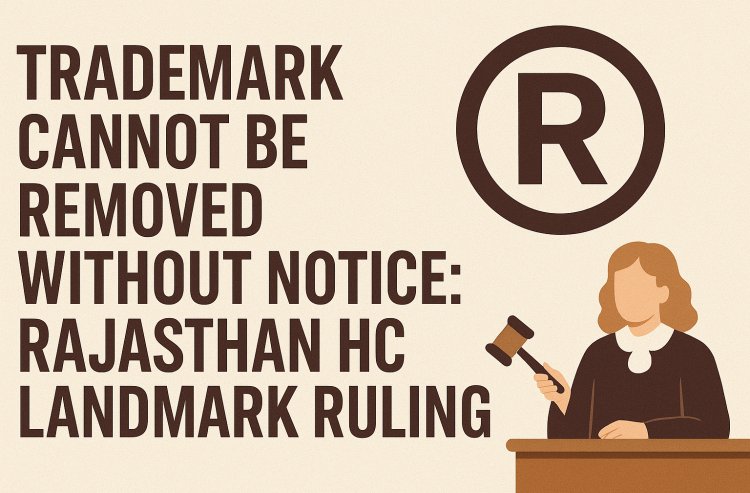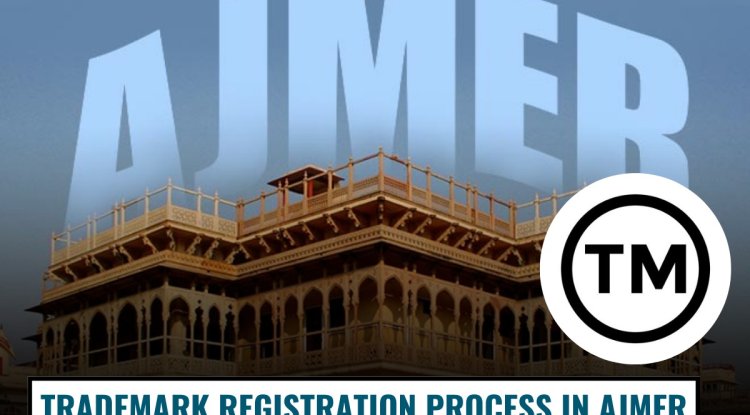Trademark Cannot Be Removed Without Notice: Rajasthan HC Landmark Ruling
In Jitendra Goyal v. Registrar of Trade Marks (2025 SCC OnLine Raj 3294), the Rajasthan High Court ruled that removal of a registered trademark without prior notice violates Section 25(3) of the Trade Marks Act, 1999. Justice Anoop Kumar Dhand emphasized that issuing notice is a statutory obligation, not a discretionary act, reinforcing principles of natural justice. The decision underscores that the Registrar must adhere to due process before cancelling or removing trademarks, safeguarding the rights of registered proprietors and strengthening procedural integrity within India’s trademark administration.

INTRODUCTION
In a significant decision dated 1 July 2025, the Rajasthan High Court addressed the issue of when a registered trade mark can lawfully be removed from the Register under the Trade Marks Act. In the case of Jitendra Goyal v. Registrar of Trade Marks. The Court held that a trade mark cannot be removed from official records without issuance of the notice mandated under Section 25(3) of the Act (together with the corresponding Rule 58 of the Trade Marks Rules, 2017). This ruling emphasises that the Registrar’s procedure is not discretionary but mandatory — failure to issue the notice renders the removal legally unsustainable.
SUMMARY OF DECISION AND IMPLEMENTATION
The Court found that the Registrar of Trade Marks failed to serve a mandatory notice under Section 25(3) of the Trade Marks Act, 1999 and Rule 58 of the, before removing the petitioner's trade mark from the register. The removal was therefore unlawful. The order to remove the trade mark was quashed, with directions that the Registrar must comply with the required provisions and offer a fair hearing before issuing any new orders affecting the petitioner's registration or renewal. Should the petitioner now submit an application for renewal, it must be decided in accordance with the law.
RELEVANCE OF SECTION 25(3) OF THE TRADEMARKS ACT, 1999 AND RULE 58 OF THE TRADE MARKS RULES, 2017
SECTION 25(3). Duration, renewal, removal and restoration of registration. —
When it comes to the renewal of a trademark registration, the Registrar plays an essential role. Before the current registration expires, they will send a friendly reminder to the registered owner. This notice includes the expiration date and details on the fees and conditions needed to renew the trademark. If the owner doesn't meet these requirements by the given deadline, the trademark may be removed from the register. However, there's good news! If an application is submitted in the correct format, along with the necessary fee and surcharge, within six months after the registration expires, the Registrar will not remove the trademark. Instead, they will happily renew it for another ten-year period. It's a helpful system designed to keep trademarks current and protected.
RULE 58, Trade Marks Rules, 2017-Notice before removal of trademark from register.
1. If a trademark is about to expire and no application for renewal has been received, the Registrar will reach out to the registered proprietor. This notice will be sent using Form RG-3 and will arrive no more than six months before the registration expires. It will provide information about the upcoming expiration date and any conditions that need to be met for renewing the trademark registration. This way, trademark owners can stay informed and take the necessary steps to maintain their rights.
2. According to Rule 58 of the Trade Marks Rules, 2017, there are specific procedures in place regarding the renewal of trademark registrations. If a trademark is due for renewal and has been registered within six months prior to the renewal date, you can still renew it by paying the renewal fee within six months after the actual registration date. However, it's important to be aware that if the renewal fee isn't paid within that time frame, the Registrar is required to remove the trademark from the register, following the guidelines outlined in Rule 60. So, make sure to keep track of your renewal dates to avoid any surprises.
3. In accordance with Rule 58 of the Trade Marks Rules 2017, it's important to note the process regarding trademark renewal. If a trademark's registration is due for renewal but is registered after the renewal date, there is a grace period of six months during which you can still renew it by paying the renewal fee. However, if the fee isn’t paid within that six-month window, the Registrar will be required to remove the trademark from the register, in line with rule 60. So, make sure to stay on top of those renewal deadlines to keep your trademark protected.
4. According to Rule 58 of the Trade Marks Rules, 2017, it's important to note that before a trademark is removed from the register, a notice must be given. When it comes to renewing the registration of a collective trademark or a certification trademark, this must be done using Form TM-R, along with the required fee outlined in the First Schedule. Making sure to follow these guidelines helps ensure that trademarks remain protected and in good standing.
CORE ISSUE
Petition challenging removal of Trade Mark "Lala Ji Diamond Agarbatti" without compliance of statutory notice provisions under Section 25(3) of Trade Marks Act, 1999 and Rule 58 of Trade Marks Rules, 2017.
RELIEF SOUGHT
· Direction to grant registration/renewal of Trade Mark No. 857965 dated 25.05.1999;
· Award of cost;
· Other appropriate writ/order/direction as deemed fit.
To know more about this you can follow the link below:
PETITIONER'S ARGUMENTS
· Trade Mark was valid till 25.05.2009.
· No renewal application was submitted post expiry.
· Respondent failed to issue mandatory notice before removal as required by law.
RESPONDENT'S ARGUMENTS
· Documents filed by petitioner not sufficient.
· No renewal application for over seven years.
· Removal of Trade Mark from records legally justified.
KEY PROVISIONS
· Section 25(3), Trade Marks Act, 1999: Mandatory notice before removal of trademark.
· Rule 58, Trade Marks Rules, 2017: Process and form of notice for removal.
COURT'S FINDINGS
· No evidence of compliance with notice requirement before removal.
· Removal of Trademark without notice is contrary to law.
· Action of removal quashed and set aside.
FINAL ORDER
· Writ petition allowed.
· Respondent at liberty to pass fresh order after due compliance with statutory provisions and opportunity of hearing.
· Any application for renewal now to be considered as per law.
CONCLUSION
The Jitendra Goyal judgment is an important development for fairness in India’s trademark system. It highlights that administrative processes should never sacrifice fairness for convenience. By requiring notice issuance under Section 25(3), the ruling ensures protection against the unjust removal of trademarks that hold significant value for their owners. This decision sets a strong precedent for trademark registries across India to strictly follow due process before removing any marks. It also reminds trademark owners to keep their registrations active with timely renewals and updated contact information to receive important notices. Overall, this ruling boost confidence in India’s intellectual property system, reinforcing the importance of procedural fairness and legal certainty in trademark administration.












